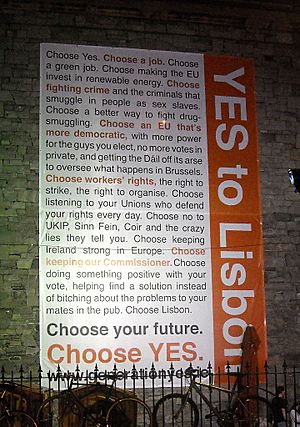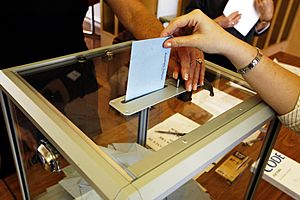Plebiscite facts for kids

A referendum or plebiscite is a special type of vote. It lets all the people in a country or region decide on a specific issue. This issue is often about a new law, a big change to the country's rules (its constitution), or an important government decision. It's a way for citizens to have a direct say.
Some people use the words "referendum" and "plebiscite" differently. For example, in Australia, a "referendum" is always about changing the country's constitution. A "plebiscite" is a vote on something else that does not change the constitution.
Contents
How Do Referendums Work?
When people vote in a referendum, the result can have different levels of power.
Mandatory Votes
Sometimes, the result of a referendum is mandatory. This means the government must follow what the people have decided. For example, in Switzerland, referendums are usually mandatory. This is because the people are seen as the main source of the government's power.
Advisory Votes
Other times, the result is only advisory. This means the vote helps the government make a choice, but they don't have to follow it exactly. In the United Kingdom, referendums have often been advisory. This is because the government believes that elected members of Parliament should make the final decisions. However, the Scottish independence referendum was an exception. That vote was legally binding for Scotland.
Real-Life Examples of Referendums
Referendums have been held in many countries on important topics.
European Union Decisions
In 2005, some countries held referendums on a new European Constitution. Both France and The Netherlands voted "no" to the idea. Because of these "no" votes, the constitution was not created.
Another example happened in 2011 in Greece. The Prime Minister, George Papandreou, thought about letting the Greek people vote. They would decide if Greece should accept a large financial help package from the European Union. This idea worried other European countries. A "no" vote could have meant Greece might not pay its debts and leave the European Union. However, this vote was later cancelled.
Cyprus Peace Plan
In 2004, two separate referendums took place on the island of Cyprus. People in the Turkish Republic of Northern Cyprus and the Republic of Cyprus voted on a plan to settle their differences. The plan was approved by 65% of Turkish Cypriots. But it was rejected by 75% of Greek Cypriots.
Challenges with Referendums
While referendums can help solve political problems, some people worry about them.
Voter Knowledge
One concern is that voters might not know enough about a complex issue. They might not fully understand what they are voting for.
Selfish Voting
Some thinkers believe that voters might vote based on their own feelings. They might think about what benefits them personally. This could happen instead of focusing on what is best for the whole country.
Images for kids
-
The ballot from the 1946 Italian institutional referendum. People voted to decide if Italy should be a republic or a monarchy.
See also
 In Spanish: Referendo para niños
In Spanish: Referendo para niños





